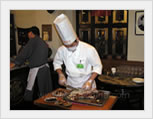
Site of Daming Palace Guide
-Travel to Site of Daming Palace Featuring its super-large scale and magnificent buildings, Daming Palace was the main royal palace in Tang Dynasty (618 - 907) where Tang emperors lived and dealt with state affairs.
Featuring its super-large scale and magnificent buildings, Daming Palace was the main royal palace in Tang Dynasty (618 - 907) where Tang emperors lived and dealt with state affairs.
The palace was located on high land in Longshou, in the northeast of Chang'an City (today's Xian). Covering a large area of 1.2 square miles, it measured 1.6 miles long and 0.9 miles wide. Originally, the Emperor Li Shimin built it as the summer palace for his father, the Emperor Li Yuan. The palace had nine gates. The whole layout was composed of two areas, Qian Chao where emperors held court, and Nei Ting used for living and recreation.
Qian Chao comprised three palaces: Hanyuan where grand ceremonies were held, Xuanzheng where emperors administered state affairs, and Zichen where ministers were presented to meet the emperor. Among them, Hanyuan Palace was the most famous and greatest.
 Hanyuan Palace was the main palace, located about 656 yards from Danfeng Gate, the middle south gate of Daming Palace. In the Tang Dynasty, it was an important international exchange center. On every New Year's Day, the emperors would hold great ceremonies there, and welcome ambassadors from various countries and the surrounding minorities. This majestic building reflected the great Tang Dynasty's prosperous and broad culture and represented the highest architectural level of that time.
Hanyuan Palace was the main palace, located about 656 yards from Danfeng Gate, the middle south gate of Daming Palace. In the Tang Dynasty, it was an important international exchange center. On every New Year's Day, the emperors would hold great ceremonies there, and welcome ambassadors from various countries and the surrounding minorities. This majestic building reflected the great Tang Dynasty's prosperous and broad culture and represented the highest architectural level of that time.
The north part of Daming Palace was the garden areas for living and recreation. Linde Palace, located in the northwest, was the biggest attached palace. It was the place where emperors held banquets and received ambassadors. Built in rammed-earth construction, the site measured 142 yards long and over 87 yards wide. Taiye Pond, also called Penglai Pond was an oval-shaped pond, covering an area of 1.6 hectare. As beautiful as a fairyland, the royal pond absorbed the essence of Tang's garden architecture.
 The palace also had countless attractive and elegant attached buildings - pavilions, towers, and corridors. It is said that the Forbidden City was built according to the layout of Daming Palace. But to everyone's disappointment, this grand palace was burned out in the flames of war at the end of the Tang Dynasty. The cruel war left only the desolate and ruined site for us to imagine its glorious past.
The palace also had countless attractive and elegant attached buildings - pavilions, towers, and corridors. It is said that the Forbidden City was built according to the layout of Daming Palace. But to everyone's disappointment, this grand palace was burned out in the flames of war at the end of the Tang Dynasty. The cruel war left only the desolate and ruined site for us to imagine its glorious past.
Since 1950s, the archaeology work to Daming Palace has begun, and by far remarkable achievements have been gained through all experts' hard work. Besides the exploration in full scale, the experts made more efforts to unearth the sites of Hanyuan Palace, Linde Palace, Sanqing Palace, Xuanwu Gate and Chongquan Gate. In 1961, the State Council declared it as the national key cultural relic protection unit. The Daming Palace has been rebuilt and opened to the public on October 1st, 2010.
More Attractions in Xian
- The Big Wild Goose Pagoda
- The Ancient City Wall
- Tang Dynasty Dance and Music
- Tomb of Emperor QinShiHuang
- Imperial Dumpling Banquet
- Terra-Cotta Warriors
- Mt. Hua
- The Great Mosque
- the Bell Tower
- Huaqing Hot Springs
- Shanxi Provincial History Museum
- The Drum Tower
- Xian Famen Temple
- Xian Banpo Museum
- Qianling Mausoleum
- Xi’an Muslim Street
- Forest of Stone Steles Museum Xian
- Site of Daming Palace
Your Question & Quick Answer*We welcome and appreciate your questions & reviews
Booking Procedures | Terms & Conditions | Payment Methods | Links | Site Map | About Us | Contact Us | Travel Agent
Copyright 2008, All rights reserved.. itourbeijing.com professional china travel guide and china travel service
TEL: 86-10-85711972 (Universal) 1-888-288-9328 (North America) E-mail: contact@itourbeijng.com
Tours Index | China Tours | Beijing Tours | Xi'an Tours | Shanghai Tours | Guilin Tours | Tibet Tours
China Travel | Beijing Travel | Shanghai Travel | Xi'an Travel | Guilin Travel |Beijing Map
China Golf | Beijing Golf | Shanghai Golf | Xiamen Golf | The Great Wall Travel | Yangtze Cruise | Travel Picture



